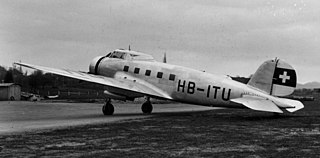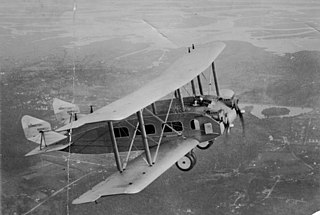
The Junkers G.38 was a large German four-engine transport aircraft that first flew in 1929. Two examples were constructed in Germany. Both aircraft flew as a commercial transport within Europe in the years leading up to World War II.

The Avro 691 Lancastrian was a British and Canadian passenger and mail transport aircraft of the 1940s and 1950s developed from the Avro Lancaster heavy bomber. The Lancastrian was basically a modified Lancaster bomber without armour or armament and with the gun turrets replaced by streamlined metal fairings, including a new nose section. The initial batch was converted directly from Lancasters; later batches were new builds.

The Bristol Type 170 Superfreighter Mk 32 was a larger, stretched version of the Bristol Freighter designed for Silver City Airways for use on the short air ferry routes to France.

The Boeing Model 200 Monomail was an American mail plane of the early 1930s.

Vincent Justus Burnelli was an American aeronautics engineer, instrumental in furthering the lifting body and flying wing concept.
The Auster Avis was a four-seat light aircraft developed from the Auster Autocrat. It featured a redesigned fuselage incorporating four doors and a circular cross-section towards the tail, new undercarriage, and new wing flaps. It was planned in two versions, the Mk 1 for civil use, and the Mk 2 for military and air ambulance duties. However, only two prototypes were built, and Auster abandoned the project in favour of the Auster J-5 Autocar.

The Burnelli UB-14 and a developed variant named OA-1 Clyde Clipper were 1930s American prototype lifting-fuselage airliners designed by Vincent Burnelli, who was responsible for constructing the first two examples.

The General Aviation GA-43 was a single engine low-wing monoplane airliner produced in small numbers in the United States in the mid-1930s, also known as the Pilgrim 150, Fairchild 150, and sometimes but erroneously as the Clark GA-43 for the designer, Virginius E. Clark who was also responsible for the Clark Y airfoil section used.

The Stearman M-2 Speedmail was a mail-carrier aircraft produced by the Stearman Aircraft Company of Wichita, Kansas. It first flew in January 1929. The Speedmail was a single-seat biplane, with two large cargo compartments in place of a front cockpit. The fuselage and tail unit were constructed from welded chrome-moly steel tube faired with wooden formers and fabric covered aft of the pilot's cockpit, and detachable aluminium alloy panels covered the fuselage forward of the cockpit. The wings were constructed from spruce spars and plywood built-up ribs, all fabric covered. It differed from previous Stearman aircraft by having a tailwheel instead of a tailskid due to its size and weight.

The Spencer Amphibian Air Car is an American light amphibious aircraft. The name was first used in 1940 for a prototype air vehicle that developed into the Republic Seabee. The name was later used by its designer Percival Spencer for a series of homebuilt amphibious aircraft roughly based on the Seabee design.

The Burnelli CB-16, also known as the Uppercu-Burnelli CB-300, was a passenger aircraft designed by the American company Burnelli in 1928. It was the first twin-engined aircraft to have retractable landing gear. Only one was built.

The Burnelli RB-1 was a US twin engine biplane airliner prototype from 1920, incorporating a lifting body fuselage.

The LAK-12 is a Lithuanian mid-wing, single-seat, FAI Open Class glider that was designed and produced by Lietuviškos Aviacinės Konstrukcijos (LAK) in Lithuania and later by Sportine Aviacija and Sport Aviation USSR.
The Normand Dube Aerocruiser Plus is a four-seat Canadian amateur-built aircraft, designed by Normand Dube and produced by Aviation Normand Dube of Sainte-Anne-des-Plaines, Quebec. The aircraft is a development of the two-seat Norman Dube Aerocruiser.
The Continental KB-1, also known as KB-1 Military Biplane or KB-1 Continental Pusher, is an early design developed by the engineer Vincent Burnelli.
The Swiss Piccard Eureka was designed to be an easily transportable single seat three-axis ultralight. Its development was brought to a halt by the Swiss ban on ultralight aircraft in 1984.

The Christavia Mk IV (Christ-in-Aviation) is a Canadian homebuilt aircraft that was designed by Ron Mason and produced by Elmwood Aviation of Frankford, Ontario. The aircraft is supplied in the form of plans for amateur construction.
The ARV Griffin is a Canadian homebuilt aircraft that was designed by Dave Marsden of the University of Alberta and produced by Canada Air RV and later by AC Millennium Corp, both of Edmonton. When it was available the aircraft was supplied as a kit for amateur construction.

The 1929 Curtiss Model 53 Condor, also known as the Curtiss Model 53 Condor 18 or the Curtiss CO Condor, was a civil passenger version of the Model 52 Condor bomber. A twin-engined biplane, it carried 18 passengers.

The McMullen Mac Airliner was a late 1920s American light airliner powered by a Liberty L-12 V-12 engine of World War I origin. The sole prototype was destroyed in a hangar fire.



















